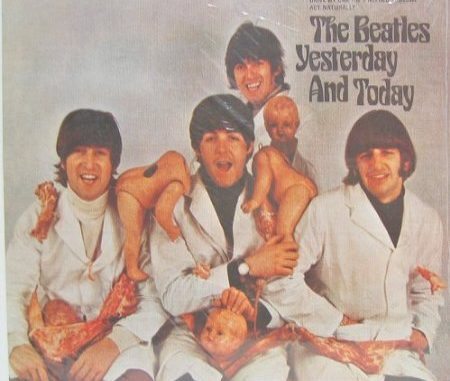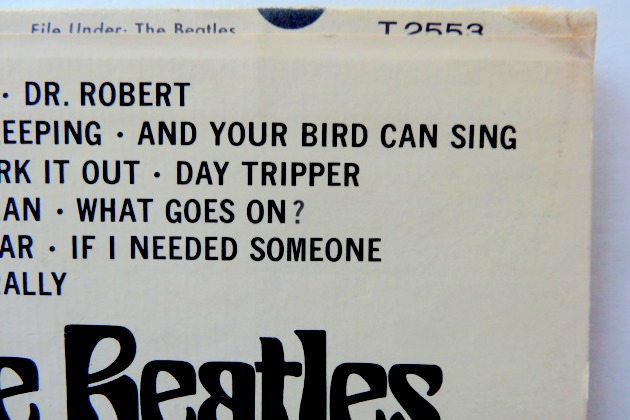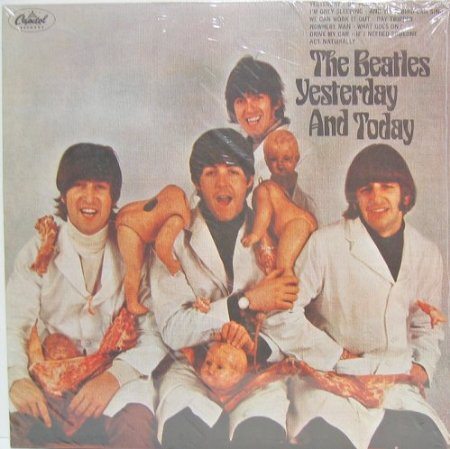

Take a close look at the photo above. See how “File Under: the Beatles” and “T 2553″ are partially obscured? Spotting that little line is like striking gold in a record store, because it suggests that you may have stumbled upon one of the holy grails of record collecting: The Beatles’ notorious “butcher cover.”
Back in 1966, there was no band bigger than the Beatles. The Fab Four could do no wrong: 10 American albums, 10 American hits. With tracks like “Yesterday,” “Day Tripper,” and “Drive My Car,” their release that year, Yesterday and Today, was another guaranteed chart-topper.
Then they stepped into their second controversy, the first happening just three months prior when John Lennon made his now famous “more popular than Jesus” comment. Photographer Robert Whitaker invited the Mop Tops to his studio for a “conceptual art piece” named “a Somnambulant Adventure.” Long story short: Instead of the same old Nehru jackets, the lads were dressed in butcher smocks and draped in doll parts and raw meat. Why depends on who you ask, but Paul McCartney allegedly claimed it was a commentary on the Vietnam War.
Regardless, 750,000 butcher jackets were printed before anybody realized that teen heart throbs decorated with meat and doll limbs probably wouldn’t go over too well. Some promo copies went out, and Yesterday and Today in what is now known as its “first state” hit the stores on June 20, 1966. On June 21, 1966, they were all recalled.
Some of those 750,000 butcher covers were destroyed. Others were tucked away in the collections of record executives and other industry insiders. The remainder were sent back to the factories, where a second cover — known as the “steamer trunk cover” or the “trunk cover” — was pasted over the butcher cover

Copies with the trunk cover pasted over the butcher cover are known to collectors as “second state” — still a butcher, but hidden beneath the more subdued cover.
The new covers weren’t always pasted straight over the originals, though, leaving hints that another cover lurked beneath the boring, posed photo of the Beatles. Some clever kids who heard rumors of the notorious butcher cover noticed a faint black triangle in the white space to the right of the trunk. That triangle is Ringo’s shirt peeking out from between the lapels of his butcher smock, which is the most essential landmark on a second state cover.
These kids enthusiastically picked at their new album covers like they were scraped knees, peeling away the steamer photo and revealing the hidden treasure below. Of course, they did this with various degrees of success, sometimes all but destroying the butcher photo and sometimes getting the new picture off fairly cleanly. Peeled covers now go by the term “third state.”
I was a kid during the ’70s, when Beatlemania was in the past and Beatles collecting was in its infancy. A butcher cover sold for $457 when I was 7 years old. That little factoid somehow made its way onto the playground – though, by the time each kid who told the story added their own spin, the sale price was a million bucks. The point here isn’t that elementary schoolers are filthy liars, but rather that even in the first grade we knew that the butcher cover was a rare and spectacular thing.
From the time I started collecting records, the butcher cover was one of my white whales. Who am I kidding? It was my white whale. There are lots of albums I’d love to have, but my inner first-grader would not rest until I found a butcher cover.
In the days before the internet, I spotted a third state cover in a Haight-Ashbury record store. It was in pretty rough shape and the owner was asking $750, so that wasn’t going to happen. That was the closest I’d ever gotten to a butcher cover outside of photos in Beatle books.
A few years later, the internet (and more specifically the auction sites) made finding a butcher cover a simple task. Recent sales on one auction site range from $100 for a poor condition third state cover (with no album) to $3,500 for an opened but still shrink-wrapped second state specimen. First state? Be ready to sell your car – they can fetch tens of thousands of dollars.
Buying a rare album online is synonymous to big game hunting caged animals, ethical dilemmas aside. How anyone derives pleasure from shooting a caged lion escapes me, and how a record collector gets the thrill of discovery from an auction site is equally baffling.
Don’t get me wrong: I’ve bought a lot of records from auction sellers, and I always will. But when it comes to chasing down my white whale, I had to catch it in the wild. (And thank you for not pointing out that one can’t shoot a caged whale.)
This weekend it finally happened. I walked into my buddy Jim’s record store, and hanging on the wall was a really nice second state Yesterday and Today. There were no splits in the spine, no hand drawn mustaches or “Tammy Loves Ringo” graffiti. It was love at first sight.
I handed Jim [mumble mumble] dollars, and my inner seven-year-old ran home as fast as he could with his new record. He didn’t want to listen to it: He wanted to peel away the steamer trunk cover and see the dangerous cargo hidden beneath.
I turned to the internet for instructions and entered the very weird world of butcher cover peeling. Fifty years of research and experimentation allow second state owners to identify where their copy was manufactured and what solvent (alcohol or saliva) works best on the glue used in that factory. There are even companies that specialize in peeling butcher covers, not to mention restoring third state covers that were poorly peeled.
As I moved from website to website, images of the butcher cover flipped past, and beside me sat my unmolested second state copy. For 50 years, somebody cared for this copy of Yesterday and Today. It was obviously stored properly — upright, protective outer sleeve, temperature-controlled low humidity environment, hidden away from sunlight.
And then I realized: I’m looking through dozens of photos of butcher covers. Why in the world would I mutilate this second state copy that had survived a half century just so that I could look at an image that I can see online whenever I choose? For that matter, if I really want to look at a 12-inch square version of the butcher sleeve, why not spend $30 for a reissued copy?
As corny as this sounds (and it probably sounds very corny), I realized at that moment that I belong to a subset of collectors that are perhaps better defined as curators. Sure, value is important to me — scarcity, all of that stuff — but my bigger concern as a vinyl hound is preservation. A big part of the pleasure that I get from my new purchase is the knowledge that it will remain safe for the next 30 years (35 if I give up french fries and hit the treadmill).
In the end, I didn’t buy a butcher cover. I paid [mumble mumble] for the obligation to keep this particular second state survivor in its current condition for as long as I am able.
And I couldn’t be happier about that.
Thanks to Diffuser FM/James Stafford for this article
Want to buy your very own ‘butcher sleeve’, EIL have a wonderful condition ‘second state’ variant in stock, for more info click here




Be the first to comment